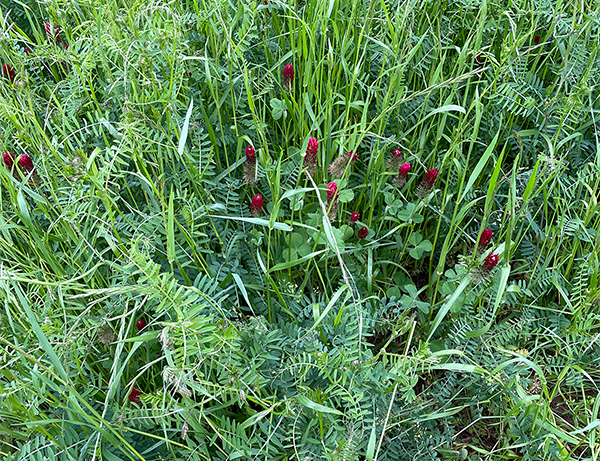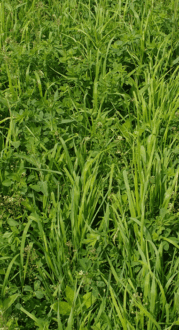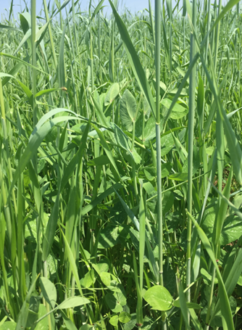Jan 21, 2024Cover crop mixes: Select right species, seeding rates
Choosing the right mixes will help assure a fair return on your investment. Here are ways to reduce the cost while maximizing the return.
Know your growing conditions
Get a sense of the growing conditions of your fields. Try growing the cover crop as a sole cover crop. Note the conditions when it thrives — and doesn’t — and how aggressive it is. If it grows fast and fills in gaps, it is a strong competitor.
Experience is key to selecting the right species at the right seed rates for your mix to grow successfully. Seed rate is not an easy determination when planning to grow several species together. Recommended rates generally listed are intended for sole crop production. Combining cover crop species to be planted in a single pass can offer a means to address several goals to improve the soil.


For example, to improve nutrient cycling, a dense stand (lots of biomass) will take up excess nutrients that otherwise may be leached. To reduce erosion, just ensuring your soil is covered might suffice.
As unprecedented weather events occur more frequently, cover crop mixes should be selected to withstand less than “normal conditions,” such as changes in soil moisture and air temperature. Think of this mix (vs. a single crop) as a way to hedge your bets against less predictable weather.
Address multiple goals with cover crop mixes
How much seed of each cover crop species should be included? Consider several factors about each cover crop: Does it address at least one of the soil’s needs (goals), how well does it grow, and what are its abilities to grow with other plants in the mix? If a species is being grown under less-than-optimal conditions, consider replacing it with a more competitive species or increasing the seed rate by about 10%.
Seeding rates


If you plant a mix, you want to see the species grow evenly so all are present and addressing your goals. Cover crop mixes that grow evenly and do not outcompete one another provide multiple benefits.
It’s important to note that a species may grow well one year but is hardly visible the next. This is OK — the mix is adjusting to the varying growing conditions.
Even if this is the case, you still want to ensure that the lack of species present is not because the seeding rate of another species is too high. Careful planning is needed to manage highly aggressive species in cover crop mixes. This can be done by decreasing the seeding rate, which will reduce your costs and plant competition.
For example, when sorghum sudangrass (aka Sudex) was part of a summer annual cover crop mix, it grew fast in warm weather, tillered, and was often too competitive with other plants. This is one example discussed in Bybee-Finley’s et al. article (2022). Also, if a legume seed cost is too high, you may want to reduce its seed rate, but note that legumes are often less competitive when there is adequate nitrogen in the soil because legumes grow best in lower nitrogen soil.
Some plants are more competitive when grown as a sole crop (intraspecific competition) but less competitive when grown in a mixture of species (interspecific competition), such as pearl millet. This species “plays well with others” and can fill in the gaps.
Plant growth rates


Choose cover crops species that can grow well in your environment and at the time of year they are planted. Selecting species with different physical traits often provides different functions. For example, some cover crops (such as Daikon radish) produce a tap root and help with soil drainage.
Plants with fibrous roots such as cereal rye will help reduce erosion. When grown together, they can fill the space collectively, above and below ground. This aspect is a key reason to grow mixes, as they increase soil cover and weed competition in addition to providing their own contributions.
Strive to adjust the rate for each species to obtain a more even stand and get the most out of your investment. This approach will increase effectiveness of the mix and may even reduce seed cost. Three- and four-way mixes are the most practical number of species to include and can address several goals in one season. This has been shown in several field research studies.
Incorporating these considerations when choosing seed rate and seed mixes may not produce a perfect cover crop, but be a great improvement over using one-crop species and single seed-planting rate.
If you want a little assistance to choose the cover crop mixture, check out this Decision Tree by Ann Bybee-Finley.
—Vicki Marrone and Ann Bybee-Finley
Vicki Marrone is an academic specialist at Michigan State University ([email protected]) and Ann Bybee-Finley is a USDA postdoctoral researcher ([email protected]).














